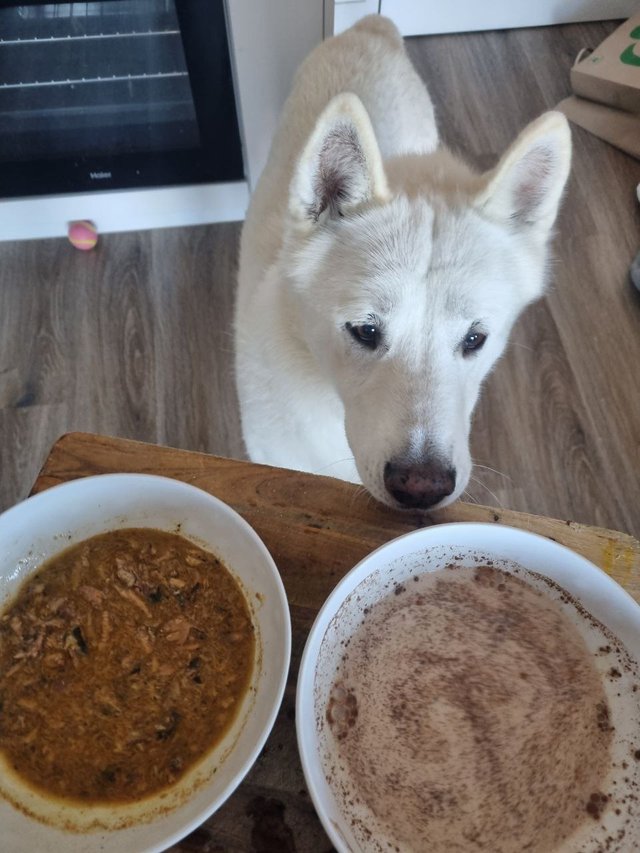Polar’s ASAC Journey: Choosing Metabolic Therapy with Seyfried and Makis
Polar, my 10-year-old all-white Siberian Husky, is battling apocrine gland anal sac adenocarcinoma (ASAC), a rare cancer with a ~5–15% remission rate under standard care (web:18,19,20). I’m Zaak, his caregiver, and as of May 14, 2025, I’m sharing why we chose a metabolic therapy path to fight the primary ASAC tumor and a late-blooming secondary tumor, even as secondary biopsy-related tumors have resolved, restoring much of the contour edges where veterinarians typically perform biopsies.
Early Challenges and a Toxic Trigger
Polar’s struggles began before his ASAC diagnosis in late 2024. As early as January 2024, or possibly earlier, he faced persistent constipation and issues with his hindquarters that we couldn’t fully resolve. Around January 2024, a landscaper applied Roundup poison in Polar’s yard, ignoring instructions due to his idiopathic epilepsy—a potential carcinogen exposure that may have increased his cancer risk (web:21). By May 2024, I noticed a lump near his perianal region, leading to vet visits for gland-related issues in June 2024 and the ASAC diagnosis later that year.
Mainstream Vets: Limited Options
Mainstream vets recommended surgery. In July and August 2024, they advised removing the tumor and desexing, despite excessive bleeding after fine needle aspiration (FNA) biopsies (vet notes: 7/4/24, 8/5/24). They didn’t fully explain biopsy risks, and secondary tumors appeared weeks later, including a white cyst-like growth (vet notes: 7/7/24). Sampling the edges of the tumor, a common practice to avoid the vascular main tumor site, likely contributed to these biopsy-related growths (web:10,12,15). Surgery near the perianal region risked complications, especially with Polar’s unresolved constipation requiring manual assistance for months (vet notes: 8/5/24). Their focus on invasive procedures didn’t fully consider Polar’s unique needs.
When I asked about metabolic therapies, the vets were cautious, likely due to professional guidelines limiting their ability to explore treatments beyond standard protocols. One suggested fenbendazole would have minimal impact, while another noted a low-carb diet might not provide enough energy, overlooking research on metabolic approaches. Their reserved stance is understandable, as they must adhere to conventional practices.
Metabolic Therapy: Our Starting Point
In June 2024, I explored research on ketogenic diets for cancer, finding evidence of remission through ketosis. Using a calculator for Polar’s weight (25.4kg then, now 23.8kg), I shifted him to a ketogenic diet in July 2024 to starve cancer cells of glucose. Huskies’ prehistoric lifestyle—fasting while hunting, eating high-fat, low-carb prey like fish or meat, then fasting again—aligns with their naturally ketogenic metabolism (vet notes: 11/11/24). A press-pulse protocol using fenbendazole (222mg/day, 3 days on, 4 days off) became our foundation.
Early on, I used berberine and golden turmeric paste to manage Polar’s tumor site, which reduced bleeding without worsening his condition (vet notes: 11/11/24). However, the initial ketogenic diet (chicken, sardines, unsaturated fats) aggravated his constipation, highlighting the need for a tailored approach.
Holistic Breakthrough and Ongoing Fight
Polar’s constipation persisted until mid-November 2024, when a holistic veterinary practice prescribed a tailored ketogenic diet (60% fish, 40% pork), resolving his bowel movements (vet notes: 11/11/24). Surgery from May to November 2024 would have been risky—Polar’s straining could have disrupted healing, especially with my manual assistance for defecation. The holistic vet supported fenbendazole (222mg/day, 3 days on, 4 days off, later up to 444mg/day, vet notes: 1/16/25), acupuncture, probiotics, and a cooling/neutral diet to address cancer’s “phlegm” (vet notes: 11/11/24). Additional treatments, including ivermectin cream (Soolantra), milk thistle, DMSO, bicarbonate soda, and CBD oil (0.5mg/kg, increasing gradually), were added by May 2025 (vet notes: 1/16/25, 5/8/25).
Progress and Continued Battle
By May 2025, secondary biopsy-related tumors, likely from sampling the tumor edges, had largely resolved, restoring much of the contour edges where vets typically perform biopsies (vet notes: 5/8/25). However, we continue to battle the primary ASAC tumor and a late-blooming secondary tumor, with a 1cm ulcer still present (vet notes: 5/8/25). The holistic vet noted Polar’s improved condition, with no visible metastasis (though CT/MRI would confirm). While these gains are encouraging, Polar’s fight is far from over. The metabolic therapy protocol has reduced inflammation and stabilized his condition, showing promise as we push for remission.
Why Metabolic Therapy? A Tailored Fight
We chose this path because mainstream recommendations didn’t fully address Polar’s epilepsy, persistent constipation, or surgical risks—especially with biopsy-induced secondary tumors and ASAC’s 26–96% metastatic rate (ScienceDirect). A carb-heavy diet (biscuits, rice, beef, chicken) would have fueled the tumor’s glucose needs, and surgery risked recurrence and healing complications. Metabolic therapy, rooted in Polar’s ketogenic biology, bypasses the limitations of standard care.
Join Polar’s Storm
Polar’s fight is a beacon of hope, and $POLAR’s community is his strength! Join #PolarInuArmy at t.me/PolarInu_SOL to support our Solana 489V contract, with a dual-chain surge (Solana & Ethereum) if Polar triumphs!
Solana Contract Address: 489VqxA4P6Geg3hUDJEfUxD79mU5axaDnX8Fzauepump
Chart: https://dexscreener.com/solana/489VqxA4P6Geg3hUDJEfUxD79mU5axaDnX8Fzauepump
X: x.com/PolarInu_Solana
TikTok: tiktok.com/@PolarInu_SOL
Instagram: instagram.com/PolarInu_SOL
Telegram: t.me/PolarInu_SOL
Steemit: steemit.com/@polarinu
Website: PolarInu.xyz

